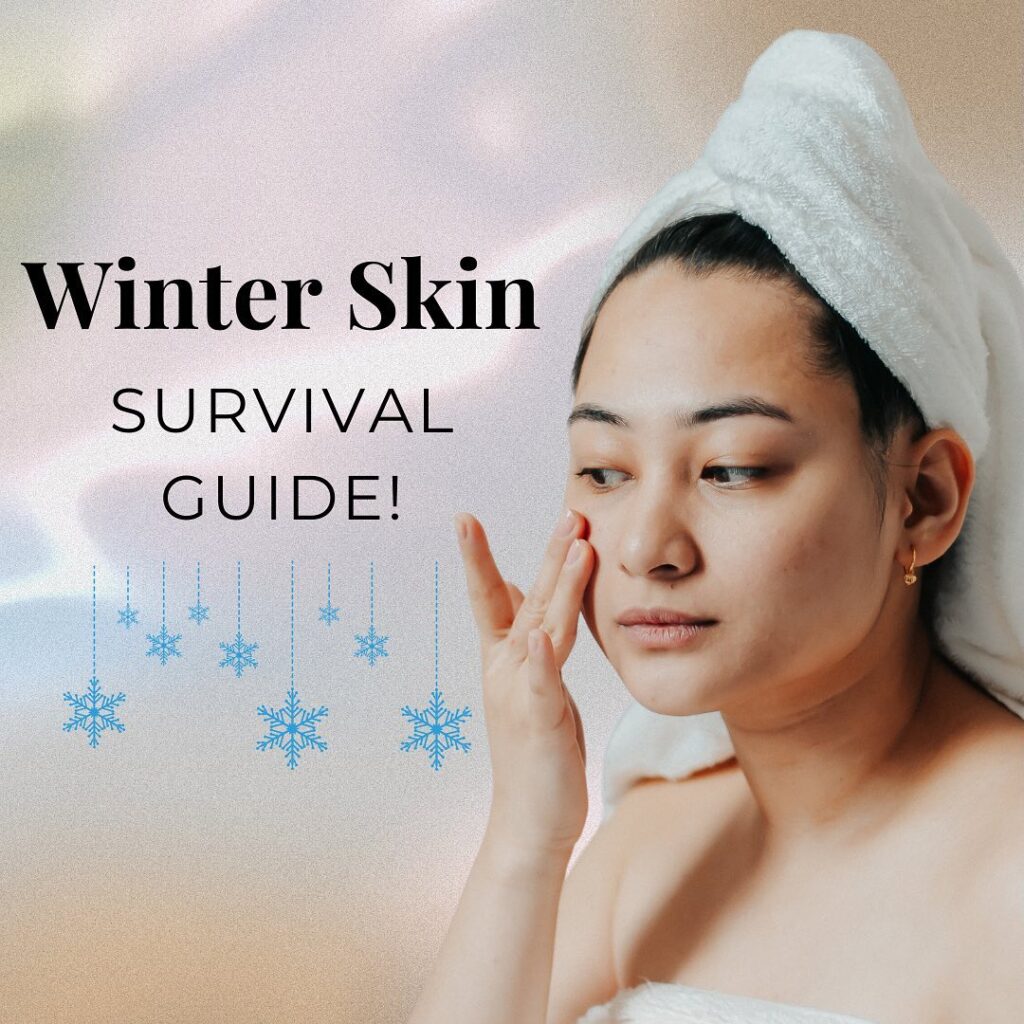
Introduction: Why Snowy Regions Are Hard on Your Skin
Living in snowy, cold climates means battling dry, flaky, and irritated skin on a daily basis. The cold air, low humidity, and harsh winds take a toll on the skin, stripping it of natural moisture and leaving it vulnerable to environmental stressors. This guide will provide you with a comprehensive skincare routine to keep your skin healthy, hydrated, and glowing throughout the cold months. Whether you have sensitive, oily, or combination skin, these tips and tricks will help you protect your skin from the damage caused by extreme winter conditions.
Understanding the Impact of Cold Weather on Your Skin
Before we dive into the skincare solutions, it’s important to understand why the cold weather causes such havoc on your skin.
- Cold Air and Low Humidity: In winter, the air is dry, and humidity levels drop significantly. This leads to a decrease in moisture in your skin, causing it to feel tight, dry, and sometimes flaky. According to dermatologists, the skin loses up to 25% of its moisture in extremely dry conditions, leading to dehydration and irritation.
- Cold Winds: The biting cold wind strips the skin of its natural oils, further depleting the moisture barrier. This leaves skin vulnerable to chapping and cracking. Sensitive areas like your lips, hands, and the area around the eyes are especially prone to damage.
- Indoor Heating: While indoor heating systems provide warmth, they also dry out the air, which can exacerbate skin dehydration. This often results in dull, rough, and itchy skin.
Now that we know why winter is so harsh on our skin, let’s go through a comprehensive skincare routine to help combat these challenges.
Step 1: Hydrate from the Inside Out
Why Hydration Matters:
Cold weather can dehydrate your skin quickly, but hydration starts from the inside. Proper water intake helps to maintain your skin’s moisture levels and overall health. Aim for at least 8 glasses of water a day, and consider hydrating foods like fruits (e.g., oranges, apples), vegetables (e.g., cucumbers, celery), and herbal teas to give your skin the extra moisture it needs.
Tips for Staying Hydrated in Winter:
- Use a humidifier: Indoor heating can make the air extremely dry, which dehydrates your skin. A humidifier can add moisture back into the air, which helps maintain skin hydration.
- Limit caffeine and alcohol: Both are diuretics, which can cause you to lose more moisture from your body.
- Drink water with electrolytes: Add electrolyte-enhanced water or a pinch of salt to your water for better hydration, as electrolytes help retain moisture in the skin.
Step 2: Use a Gentle, Hydrating Cleanser
During winter, you want to avoid stripping your skin of its natural oils, which are essential for maintaining hydration. Harsh soaps can leave your skin feeling tight and dry.
What to Look for in a Cleanser:
- Hydrating ingredients: Look for cleansers that contain glycerin, hyaluronic acid, or ceramides. These ingredients help attract moisture to the skin while cleansing.
- Avoid sulfates: Sulfates can be overly drying, so choose a sulfate-free cleanser.
Recommended Cleansers:
- CeraVe Hydrating Cleanser: Contains ceramides and hyaluronic acid, ideal for restoring moisture.
- La Roche-Posay Toleriane Hydrating Gentle Cleanser: Great for sensitive skin, free from sulfates, and enriched with glycerin to maintain skin hydration.
Step 3: Exfoliate Gently (But Not Too Often)
Exfoliation removes dead skin cells and helps improve the absorption of moisturizers. However, in winter, you need to be extra gentle, as over-exfoliating can damage the skin’s delicate moisture barrier.
How Often Should You Exfoliate in Winter?
- Once or twice a week should be sufficient, depending on your skin type.
- For sensitive skin, stick to gentle exfoliants with lactic acid or fruit enzymes. Avoid harsh physical scrubs.
Exfoliants to Consider:
- The Ordinary Glycolic Acid 7% Toning Solution: A gentle chemical exfoliant that sloughs off dead skin without being abrasive.
- Neutrogena Hydro Boost Exfoliating Cleanser: Contains gentle microbeads and hyaluronic acid to hydrate while exfoliating.
Step 4: Moisturize with Rich, Hydrating Creams
Winter skincare is all about keeping moisture locked in. Using the right moisturizer can prevent dryness, flakiness, and irritation.
What Makes a Good Winter Moisturizer?
- Thick, creamy formulas: Look for rich moisturizers that can provide a protective barrier to prevent moisture loss.
- Ingredients to prioritize: Choose products with hyaluronic acid, glycerin, ceramides, shea butter, and squalane.
Top Winter Moisturizers:
- Clinique Moisture Surge 72-Hour Auto-Replenishing Hydrator: This gel-cream provides an instant moisture boost and lasts for up to 72 hours.
- Eucerin Advanced Repair Cream: Contains ceramides and natural moisturizing factors to repair and protect dry skin.
- Neutrogena Hydro Boost Water Gel: Great for all skin types, with hyaluronic acid that draws moisture into the skin.
Step 5: Use a Humidifier and Protect Your Skin Outdoors
How a Humidifier Helps:
As mentioned, indoor heating can dry out the air, leading to moisture loss in your skin. A humidifier helps restore moisture in the air, keeping your skin hydrated.
Outdoor Skin Protection:
When venturing outside in cold, windy conditions, protect your skin with a rich lip balm and a thick moisturizer. For the face, look for a winter-specific sunscreen with added moisture to protect against both UV rays and the cold.
Outdoor Protection Tips:
- Wear a scarf or face mask to shield your skin from the wind.
- Use SPF daily, even in winter, as UV rays can still harm the skin through the snow.
- Opt for oil-based products or balms instead of lotions for more effective moisture retention.
Step 6: Target Specific Skin Conditions (Eczema, Rosacea, etc.)
Winter can exacerbate existing skin conditions like eczema, rosacea, or psoriasis. If you have one of these conditions, take extra precautions to manage your symptoms.
Winter Eczema Care:
- Use emollients like Aquaphor or CeraVe Healing Ointment to provide intense moisture and form a barrier.
- Avoid hot showers, as they can worsen eczema symptoms. Stick to lukewarm water and gentle cleansers.
Rosacea Care in Cold Weather:
- Choose products formulated for sensitive skin to avoid irritation.
- Avoid triggers like alcohol and spicy foods that can cause flare-ups.
Step 7: Overnight Care (Mask or Repairing Cream)
Overnight is the best time to give your skin an extra boost of hydration. Use a sleeping mask or a rich, nourishing night cream to repair your skin while you sleep.
Best Overnight Products:
- Laneige Water Sleeping Mask: Provides deep hydration and helps restore skin’s natural moisture barrier.
- Kiehl’s Ultra Facial Overnight Hydrating Masque: A deeply hydrating mask that replenishes moisture while you sleep.
Conclusion: Skin Care in Snowy Regions Doesn’t Have to Be a Battle
By following a tailored skincare routine that focuses on hydration, gentle cleansing, and protective measures, you can keep your skin healthy, glowing, and protected from the harsh winter elements. Winter doesn’t have to mean dry, irritated skin; with the right products and routine, your skin can remain soft, smooth, and nourished, even in the coldest climates.
Don’t forget to hydrate from the inside out, exfoliate gently, and always protect your skin with moisturizers, sunscreens, and balms designed for winter conditions. By prioritizing your skin’s needs and using the right products, you’ll be able to combat winter dryness and achieve a radiant complexion all year long.



